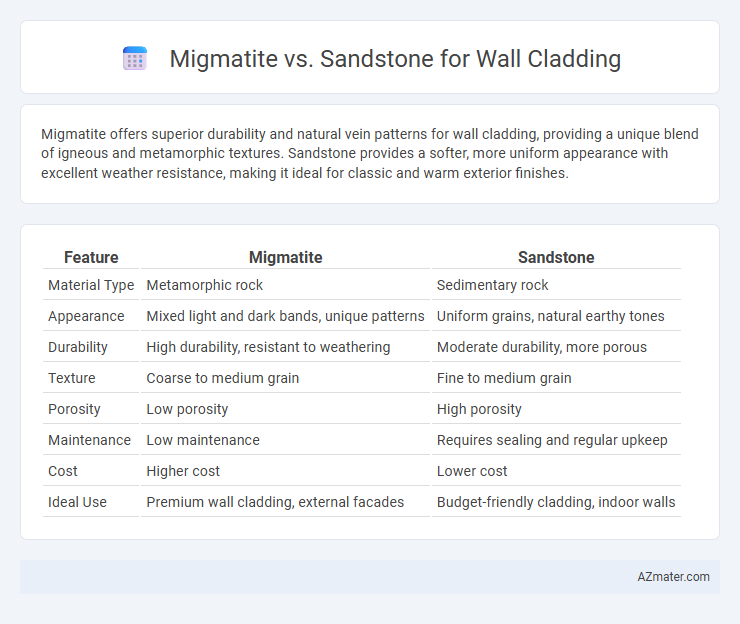Migmatite offers superior durability and natural vein patterns for wall cladding, providing a unique blend of igneous and metamorphic textures. Sandstone provides a softer, more uniform appearance with excellent weather resistance, making it ideal for classic and warm exterior finishes.
Table of Comparison
| Feature | Migmatite | Sandstone |
|---|---|---|
| Material Type | Metamorphic rock | Sedimentary rock |
| Appearance | Mixed light and dark bands, unique patterns | Uniform grains, natural earthy tones |
| Durability | High durability, resistant to weathering | Moderate durability, more porous |
| Texture | Coarse to medium grain | Fine to medium grain |
| Porosity | Low porosity | High porosity |
| Maintenance | Low maintenance | Requires sealing and regular upkeep |
| Cost | Higher cost | Lower cost |
| Ideal Use | Premium wall cladding, external facades | Budget-friendly cladding, indoor walls |
Introduction to Wall Cladding Stones
Wall cladding stones such as migmatite and sandstone offer distinct aesthetic and functional qualities for architectural exteriors. Migmatite, characterized by its mixed igneous and metamorphic textures, provides exceptional durability and unique swirling patterns suitable for modern and rustic designs. Sandstone, a sedimentary rock known for its natural grain and warm hues, delivers excellent breathability and a timeless appearance that enhances building facades with natural elegance.
What is Migmatite?
Migmatite is a complex rock formed through partial melting and metamorphism, combining igneous and metamorphic characteristics with distinct light and dark mineral bands. Its durability, resistance to weathering, and unique swirling patterns make it an excellent choice for wall cladding in both interior and exterior applications. Compared to sandstone, migmatite offers greater hardness and a more varied aesthetic, enhancing architectural designs with natural elegance.
What is Sandstone?
Sandstone is a sedimentary rock composed mainly of sand-sized mineral particles, predominantly quartz and feldspar, making it durable and weather-resistant for wall cladding applications. It features a natural, earthy texture with a range of colors including beige, red, and brown, providing aesthetic warmth and timeless appeal. Its porous structure allows for breathability, reducing moisture accumulation and ensuring longevity in both interior and exterior wall cladding projects.
Appearance and Texture Differences
Migmatite offers a unique, mottled appearance with intricate patterns blending light and dark mineral bands, creating a visually dynamic surface for wall cladding. Sandstone provides a more uniform, earthy texture with natural grain and subtle color variations, often ranging from warm beige to reddish hues. The coarse, granular feel of sandstone contrasts with migmatite's smoother, more polished finish, making each stone ideal for different aesthetic and tactile preferences in architectural design.
Durability and Strength Comparison
Migmatite exhibits superior durability and strength compared to sandstone, making it an excellent choice for wall cladding in environments requiring high resistance to weathering and mechanical stress. Its partially metamorphic nature provides a dense, interlocking mineral structure that enhances toughness and longevity, whereas sandstone, being sedimentary, is more porous and prone to erosion and surface wear over time. This inherent difference results in migmatite maintaining structural integrity and aesthetic appeal longer, especially in harsh climatic conditions.
Weather Resistance: Migmatite vs Sandstone
Migmatite offers superior weather resistance compared to sandstone due to its mixed metamorphic and igneous composition, which provides enhanced durability against moisture, temperature fluctuations, and erosion. Sandstone, being a sedimentary rock, is more porous and prone to weathering, especially in harsh climates with frequent rainfall or freeze-thaw cycles. Choosing migmatite for wall cladding ensures a longer lifespan and better resistance to environmental degradation, maintaining structural integrity and aesthetics over time.
Maintenance and Longevity
Migmatite offers superior durability and low maintenance for wall cladding due to its natural resistance to weathering, abrasion, and chemical breakdown, ensuring longevity in various climates. Sandstone, while aesthetically appealing and easier to carve, requires regular sealing and maintenance to prevent erosion, staining, and moisture absorption, which can compromise its structural integrity over time. Choosing migmatite over sandstone significantly reduces long-term upkeep costs and enhances the lifespan of exterior wall cladding.
Installation Considerations
Migmatite offers superior durability and requires specialized cutting tools due to its hard, mixed metamorphic composition, which can increase installation time and labor costs compared to sandstone. Sandstone, being softer and more porous, allows for easier shaping and fastening but demands careful sealing to prevent moisture damage. Both materials need precise anchoring systems, yet migmatite's weight necessitates reinforced supports for safe and stable wall cladding installation.
Cost Analysis of Migmatite and Sandstone
Migmatite generally costs more than sandstone due to its rarity and complex formation process, which requires specialized quarrying and cutting techniques. Sandstone is more affordable and widely available, making it a cost-effective option for large-scale wall cladding projects. Both materials vary in price based on quality, thickness, and geographic location, but sandstone typically offers better budget flexibility for commercial and residential applications.
Choosing the Best Stone for Wall Cladding
Migmatite offers superior durability and unique veined patterns making it ideal for wall cladding that demands longevity and aesthetic appeal, while sandstone provides a softer texture and warm hues that enhance natural and rustic designs. Consider environmental factors such as exposure to moisture and wear, since migmatite's high resistance to weathering outperforms sandstone in harsh conditions. Cost and maintenance also influence choice, with sandstone generally being more affordable but requiring more upkeep compared to the low-maintenance, hard-wearing migmatite.

Infographic: Migmatite vs Sandstone for Wall Cladding
 azmater.com
azmater.com